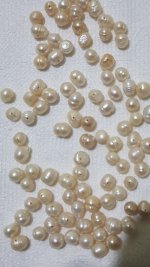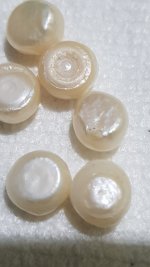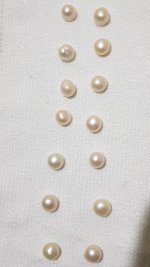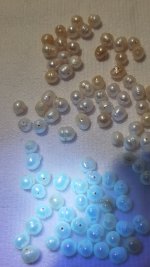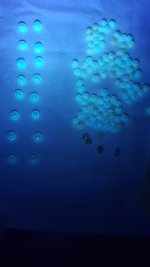These scored 10-0 : FW v Marine origin. I found it impossible to mark a single point for natural origin, nor even a contentious split.
Conclusion : Freshwater pearls.
Rationale : Unsubstantiated provenance. Conjecture. Observations lack scientific merit. Complete absence of a protocol or analytical system.
Thank you for your comments, though I must say the tone of your response seems unnecessarily dismissive.
I have clearly stated throughout this discussion that I am here to learn. I’ve asked questions in good faith and shared personal observations, along with some technical tests I have conducted — not as final conclusions, but as part of a process of understanding. Learning often involves a combination of observation, testing, and open discussion. I remain open to further scientific validation, but I hope this context is appreciated.
My references to family history were not intended as scientific evidence, but rather to provide background on the pearls in my possession, which have been passed down through generations.
I’d also like to clarify that while formal documentation may not always exist for heirlooms passed down over centuries, my family’s history is well established.
My great-grandfather was a maritime trader during the Dutch period in Zeylan (now Sri Lanka), engaged in the spice and pearl trade — a tradition our family continued until around 1890.
I must also point out that remarks which dismiss personal heritage or oral history — simply because they originate from a non-Western context — can come across as unfair and condescending.
Just to put things in perspective — if your grandfather was born in the U.S. before 1915, when no universal birth certificate system existed, what proof do you have that he was truly your grandfather or even a U.S.-born citizen? If there’s no official record, no standardized documentation, then by your own standards, isn’t that unsubstantiated provenance?
In contrast, my family has detailed public records written in our own language that trace our heritage, social standing, and contributions over thousands of years. So when someone from a country that couldn’t even issue standard birth certificates until the 20th century demands "verifiable documentation" from me for heirlooms passed down since the 1700s, it rings hollow.
Provenance isn't always paperwork. In many cultures, it is oral history, tradition, and the careful preservation of heirlooms. I’m not dismissing the importance of scientific examination — I welcome it — but history also deserves its place in the conversation.
Not every culture maintained written records in the same way, especially during colonial periods when many regions were under foreign rule. That does not invalidate a family's legacy or its preserved artifacts.
Respecting heritage — whether documented or orally transmitted — is just as important as scientific scrutiny. The two are not mutually exclusive.
What’s truly unsubstantiated is the belief that colonial powers ever operated with ethical provenance or scientific protocols when they extracted wealth from colonized nations. Where were the "analytical systems" then? Where were the "documentation protocols" when our gold, ivory, gemstones, and ancient manuscripts were seized and sent to Europe?
It’s the same pearls our ancestors harvested from the same pearl fishery grounds that ended up in royal crowns, museum displays, and auction houses — not through trade, but by force. And yet, no one then asked for provenance, consent, or analytical proof.
Now, after centuries of one-sided extraction, you're demanding "scientific merit" and "structured analysis" to recognize the truth? That’s not a lack of data — it’s a refusal to acknowledge history.
Let’s keep this conversation constructive. I believe forums like this exist not just for experts to assert dominance, but for knowledge to be shared respectfully — especially across cultures. My intention is not to claim scientific authority, but to better understand what I have inherited and what it may represent, both gemologically and historically.

